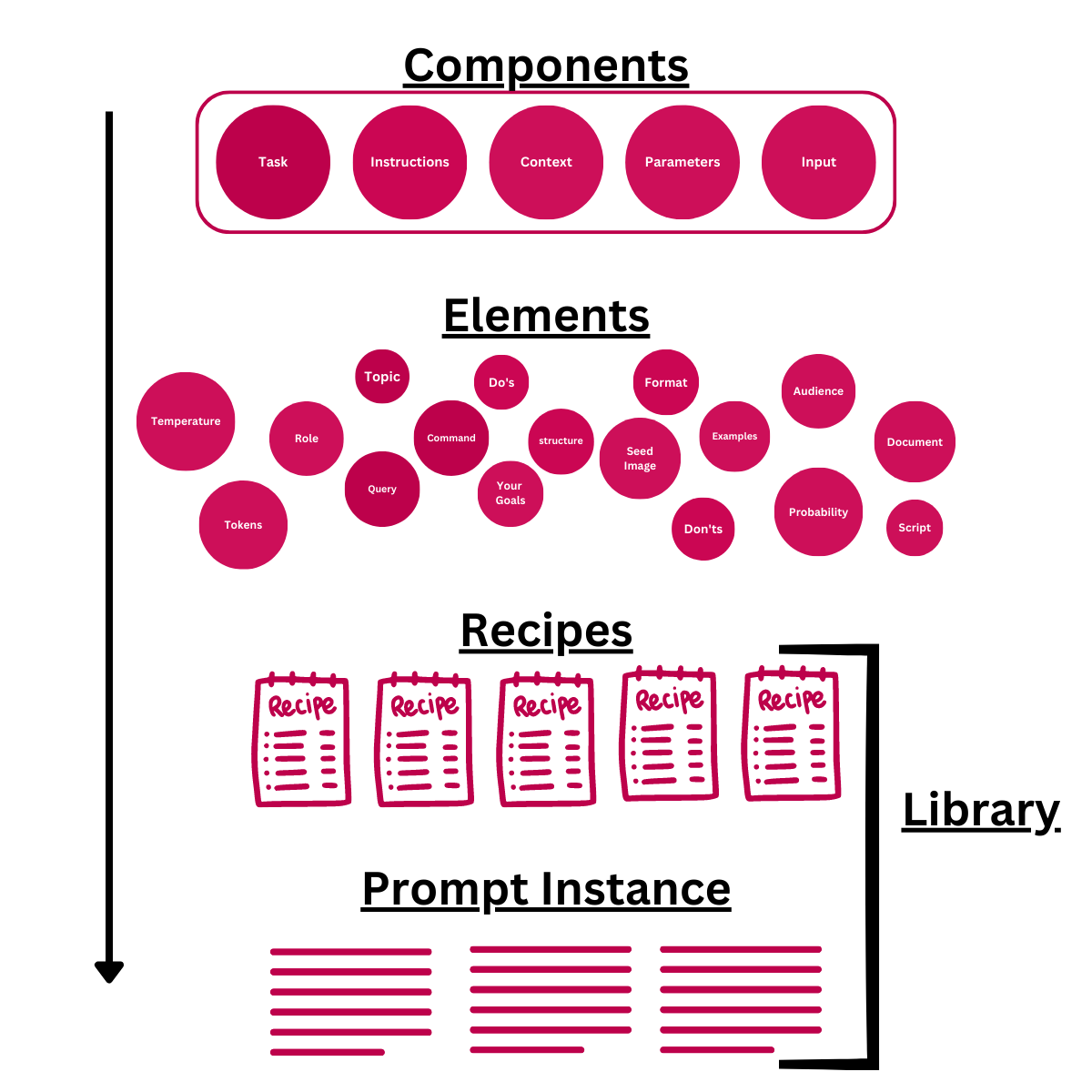In this lesson, we will explore the concept of prompt recipes, which build upon the prompt engineering techniques discussed in previous lessons. By utilizing prompt recipes, users can achieve consistency, efficiency, customization, and optimization in their AI engineering efforts.



What are Prompt Recipes?
Prompt recipes are pre-defined templates designed to facilitate creating and reusing effective prompts, ensuring consistent and repeatable results. They are built on the foundation of the four AI prompt components - Task, Instructions, Context, and Parameters/Settings - and the respective elements necessary to successfully and effectively complete the task.
Each prompt recipe contains pre-filled fields to simplify the process, with open fields for customization depending on the user's requirements.

Each prompt recipe contains pre-filled fields to simplify the process, with open fields for customization depending on the user's requirements.
Benefits of Prompt Recipes
Prompt recipes offer several benefits for effectively leveraging AI systems and streamlining prompt creation processes. Key advantages include:
- Consistency: Ensures uniform results across scenarios.
- Efficiency: Streamlines prompt creation by providing a clear structure.
- Reusability: Encourages collaboration and improves AI performance through sharing and reusing recipes.
- Customization: Allows users to tailor solutions while maintaining a predefined structure.
- Optimization: Improves AI performance by refining and fine-tuning prompts.
- Cataloging & Performance Tracking: Facilitates prompt organization, management, and tracking in a centralized repository.
- Project Organization: Enhances focus, collaboration, and decision-making by grouping prompts into projects.
- Collaborative Editing, Development, and Evaluation: Promotes knowledge sharing, innovation, and teamwork while maintaining consistency.
- Adapting Prompts from Various Sources: Enables users to integrate diverse ideas and expertise in a structured format for continuous improvement and innovation.
- Allows prompts to be programmed and parameters injected at runtime.
- Enables measured control over generated content.
Creating Your First Prompt Recipe
In this guide, we'll walk you through the steps to create a master prompt template, from choosing your preferred application to testing and refining your template. We'll also discuss the crucial attributes to store with each prompt recipe to ensure easy identification, tracking, and improvements. To get started, download our Excel prompt recipe template and follow along as we explore the world of master prompt templates.
1. Creating a Master Prompt Template:
To efficiently generate consistent AI prompts, follow these steps to create a master prompt template:
a. Choose an application: Select an application, such as MS Excel, to create and manage your prompt recipes.
b. Define core components: Outline the four main components - Task, Instructions, Context, and Parameters/Settings.
c. Create a flexible structure: Design a template that can be easily adapted and customized for various tasks and requirements.
d. Incorporate standardization: Ensure consistent terminology and formatting guidelines throughout the template.
e. Include customization options: Indicate which parts of the template can be modified and provide guidance for tailoring them.
f. Add metadata documentation: Provide detailed information on the template's purpose, usage, and customization options, including best practices for optimal AI performance.
g. Test and refine: Validate the template with example tasks and make necessary adjustments to enhance usability and effectiveness.
Prompt Recipe Template Consideration
When storing prompt recipes, it's essential to include certain attributes that provide valuable information about the recipe's purpose, usage, and performance. These attributes will help users easily identify and select the appropriate prompt recipe for their needs, as well as track its effectiveness and make improvements when necessary.
Some of the key attributes to store with each prompt recipe include:
- Recipe name: A concise and descriptive name that accurately reflects the purpose and function of the prompt recipe.
- Description: A brief overview of the prompt recipe, detailing its intended use and scope, as well as any specific features or customizations that it includes.
- Task category/domain: The specific category or domain the prompt recipe is designed for, such as SEO, image generation, recommendation systems, or other AI tasks.
- Creation date: The date the prompt recipe was created, which can be useful for tracking updates and improvements over time.
- Last modified date: The date of the most recent modification to the prompt recipe, which can help users identify the latest version and track any changes made.
- Author/creator: The name or identifier of the person or team responsible for creating the prompt recipe, which can be helpful for attribution and collaboration purposes.
- Version number: An identifier indicating the current version of the prompt recipe, which allows users to track updates and ensure they are using the most up-to-date version.
- Performance metrics: Quantitative measures of the prompt recipe's effectiveness, such as accuracy, precision, recall, or other relevant evaluation metrics. This data can help users compare and select the most suitable prompt recipes for their tasks.
- Team feedback and ratings: Qualitative feedback or ratings provided by team members or users who have previously used the prompt recipe. This information can offer valuable insights into the recipe's strengths and weaknesses and guide potential improvements.
- Customization options: A list or description of the customizable elements within the prompt recipe, such as context, instructions, or parameters/settings. This information can help users understand how to tailor the recipe to their specific needs.
Once you have created a Master Prompt Template, you can use it as the basis for all your prompt recipes. This streamlined approach will help you generate prompts faster and maintain consistency across your business, organization, or personal AI tasks. Once created you are ready for the next step.
Follow Along with this Excel Prompt Recipe Template [DOWNLOAD]
Currently, I have not identified a more effective solution for managing prompt recipes than using spreadsheets, specifically Microsoft Excel. As demonstrated in the provided file, Excel's capabilities are rooted in its formula functionality and the capacity to organize and merge text. This greatly streamlines and expedites the process of creating, editing, testing, and optimizing prompts.
Beyond simply compiling the text, Excel allows you to generate various arrangements of the same recipe in order to assess the most efficient sequence. Please utilize this Excel document as a guide to better understand our example.
2. Putting Together the Prompt Recipe:
Once you've got your master prompt template completed, make sure you refresh your memory with the prompt structure and creation process identified here:

You have two scenarios you may have when creating a prompt recipe. I outline each below and the action you need to take:
2. Create your new prompt using the method we descibed in this lesson.
When creating a new prompt, simply use your master prompt template and follow the prompt creation process we previously outlined, ensuring that each element is documented in your recipe template. Once completed, you will have a prompt recipe that can be easily reused whenever you need it.
Review the provided sheet and
2. Create a Prompt Recipe from an existing prompt
We've all seen the thousands of prompts floating around the internet on places such as Youtube, Twitter, Facebook and LinkedIn. But how do you know if it will work for you? How do you know what aspects of the prompt and what parts are actually inefficient?
Let's go through this process with a couple of examples. Again, I cannot stress enough that you understand the concepts laid out in the previous lesson before moving forward.
Example - The Marketing Assistant
I want you to act as a Marketing Personnel. Provide me with a list of potential marketing campaign ideas and strategies that could be used to increase sales and customer engagement. Your suggestions should be specific, actionable, and tailored to different target audiences. Do not provide detailed implementation plans, focus on the general concept and key selling points.
1.Find the Task by finding the Role, Command and Topic
Role: I want you to act as a Marketing Personnel.
Command: Provide me with a list of
Topic: marketing campaign ideas and strategies that could be used to increase sales and customer engagement.
2.Review and extract explicit Instructions. These mainly will deal with the attributes of the expeected output and Do's and Don'ts.
Output Format & Structure: None
Qualities of Output:Your suggestions should be specific, actionable, and tailored to different target audiences.
Content (ideas or points to include): None
Do's & Don'ts:Do not provide detailed implementation plans, focus on the general concept and key selling points
3.Add Contextual elements:Perspective, Goal, Target Audience etc
This prompt did not have any explicit contextual elements
4.Add the input you may want the AI to transform
This prompt did not require input
There you have it, your first prompt recipe. Well, we're not quite done yet. Let's take this a step further and analyse the prompt to see what are some of the opportunities for improvement and make the prompt our own.
3. Prompt Analysis: Optimising Your Prompt Recipe
Let's see how this looks in our template. Referenced the recipe template that was previously provided. Here is an excerpt from the template, Recipe ID 0002A:
| Task | Role | I want you to act as a digital Marketing Specialist working with an online publication. |
|---|---|---|
| Command | Provide me with a list of potential digital marketing campaign ideas and strategies that could be used to: | |
| Topic | increase sales and customer engagement. | |
| Instructions | Output - Format, Structure | List in bullet form in headings, then subheading format |
| Qualities of the output | Your suggestions should be specific, actionable, and tailored to different target audiences. | |
| Content (ideas or points to include} | ||
| do's and don'ts | Do not provide detailed implementation plans, focus on the general concept and key selling points. Do not mention anything about yourself or the task you have been given in your answer. | |
| Context | Perspective( you want the output to be composed from, the person you want the AI to take) | You answer will be presented to the company's board of directors |
| Your Goal (who are you, where will it be published etc.) | ||
| Target audience | ||
| Input | ||
| Parameters | ||
| Prompt | (copy and paste into ChatGPT) | I want you to act as a digital Marketing Specialist working with an online publication. Provide me with a list of potential digital marketing campaign ideas and strategies that could be used to: increase sales and customer engagement. List in bullet form in headings, then subheading format Your suggestions should be specific, actionable, and tailored to different target audiences. Do not provide detailed implementation plans, focus on the general concept and key selling points. Do not mention anything about yourself or the task you have been given in your answer. You answer will be presented to the company's board of directors |
Here is the output of this prompt. As you can see, the information is good and definitely usable. We can surely build upon it.
The potential for improvement and customization in a prompt recipe is one of the first aspects that should grab your attention. There may be several unaddressed prompt elements that the current recipe does not cover. It is important to note that not every element is required for every use case. However, if you aim to create a prompt recipe that is effective, informative, and distinct, it is advisable to fill out as much information as possible.
By ensuring that your prompt recipe includes all relevant elements, you can better tailor it to specific tasks or scenarios. This comprehensive approach not only enhances the quality of your AI prompts but also helps you create unique and adaptable solutions that cater to a wide range of requirements.
With our prompt recipe template in place, we can start seeing where the shortfalls of the original prompt are and where we can possibly improve the output.
Task
Let's begin by refining the Role. We can be more precise by focusing on digital marketing, as that is our current area of interest within the broader marketing field. Additionally, let's provide more context to the role by assigning the AI a specific job title. We should also modify the instruction to request digital marketing ideas and strategies explicitly.
Instructions
It is considered best practice in Prompt Engineering to specific the output format and structure, where possible, for the AI to understand how you would like the information presented to you. I think using bullet points and headings with subheadings might be suitable for this instance. So "List in bullet form in headings, then subheading format" is added. I also added a don't:Do not mention anything about yourself or the task you have been given in your answer.
This is to ensure the AI does not repeat anything about itself, as ChatGPT tends to do.
Context
I want to add some context, things that are a bit esoteric and hard to pin down with a few words. I think it will be useful to provide these concepts in a manner that managers and executives can also understand. To do this, rather than attempting to be too instructive, I mentioned this to the AI and allow it to use it's understanding of language to adapt the content to these personas. I added "Your answer will be presented to the company's board of directors of varying experience in marketing. Write the content in a manner they can easily understand the concepts and impact to the business"
The new prompt recipe looks like this:
| Task | Role | Provide fast and actionable insights from marketing chatbot |
|---|---|---|
| Command | I want you to act as a digital Marketing Specialist working with an online publication. | |
| Topic | Provide me with a list of potential digital marketing campaign ideas and strategies that could be used to: | |
| Instructions | Output - Format, Structure | increase sales and customer engagement. |
| Qualities of the output | List in bullet form in headings, then subheading format | |
| Content (ideas or points to include} | Your suggestions should be specific, actionable, and tailored to different target audiences. | |
| do's and don'ts | ||
| Context | Perspective( you want the output to be composed from, the person you want the AI to take) | Do not provide detailed implementation plans, focus on the general concept and key selling points. Do not mention anything about yourself or the task you have been given in your answer. |
| Your Goal (who are you, where will it be published etc.) | ||
| Target audience | Your answer will be presented to the company's board of directors of varying experience in marketing. Write the content in a manner they can easily understand the concepts and impact to the business | |
| Input | ||
| Parameters | ||
| Prompt | (copy and paste into ChatGPT) | |
| I want you to act as a digital Marketing Specialist working with an online publication. Provide me with a list of potential digital marketing campaign ideas and strategies that could be used to: increase sales and customer engagement. List in bullet form in headings, then subheading format Your suggestions should be specific, actionable, and tailored to different target audiences. Do not provide detailed implementation plans, focus on the general concept and key selling points. Do not mention anything about yourself or the task you have been given in your answer. Your answer will be presented to the company's board of directors of varying experience in marketing. Write the content in a manner they can easily understand the concepts and impact to the business |
Now let's see the output of our optimized prompt.
This appears significantly improved from the outset, with more comprehensive details and enhanced explanations. Although we could certainly continue optimizing, this lesson is already quite lengthy. Nonetheless, I believe you have all the necessary information to further develop it if you wish.
Wrap Up
Prompt recipes provide a structured and efficient way to create, reuse, and optimize AI prompts. By leveraging the benefits of consistency, efficiency, reusability, customization, optimization, cataloguing, and project organization, users can streamline their AI workflows and achieve more reliable, accurate, and effective results. With prompt recipes, users can also adapt and optimize existing prompts found on the internet, promoting experimentation and innovation in AI prompt engineering.
By creating a master prompt template and incorporating key attributes, users can effectively manage, track, and refine their prompt recipes, ultimately enhancing their AI performance and outcomes.
Found this lesson informative? Look out for our lesson on Prompt Library next in this series.









